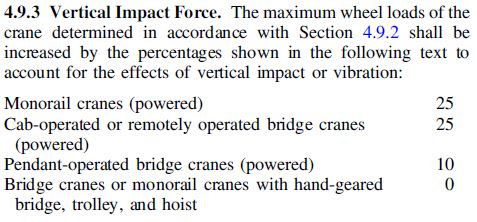DKDMA
Structural
- May 22, 2019
- 3
Reviewing section 4.9.3 in ASCE 7-16 states the following:
The maximum wheel loads shall be increased by the following percentages.
Vertical Impact Force:
Monorail Cranes (powered) - 25%
Cab-operated cranes - 25%
Pendant operated cranes - 10%
Hand-geared - 0%
I have been using 25% impact for all underhung cranes in my design work.
But now have been confronted that this is incorrect.
What constitutes Monorail Cranes? Or is the logic that it has a pendant 10%?
Can someone help and clear this up?
Thanks for your time.
The maximum wheel loads shall be increased by the following percentages.
Vertical Impact Force:
Monorail Cranes (powered) - 25%
Cab-operated cranes - 25%
Pendant operated cranes - 10%
Hand-geared - 0%
I have been using 25% impact for all underhung cranes in my design work.
But now have been confronted that this is incorrect.
What constitutes Monorail Cranes? Or is the logic that it has a pendant 10%?
Can someone help and clear this up?
Thanks for your time.


